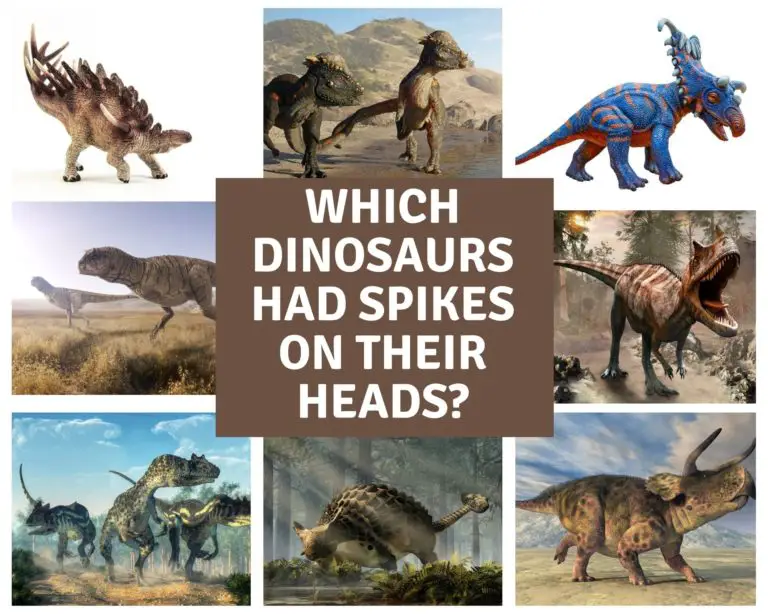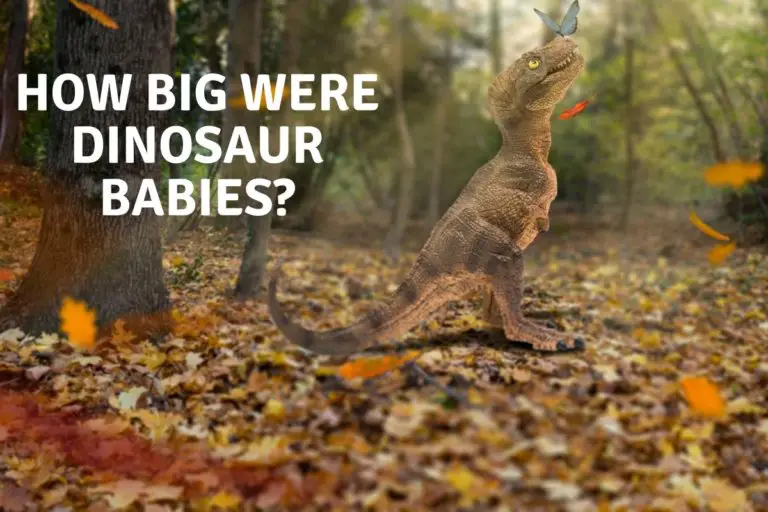What Dinosaur Has 500 Teeth?
Dinosaurs are known for their size, their length and in terms of the carnivores, their teeth. While the carnivores like T-Rex and Giganotosaurus may have had the biggest teeth, they were are long way from having the most teeth. There were plenty of dinosaurs that had over 500 teeth in their mouths and would not take a bite of you given the chance. We take a look at the most famous dinosaur with 500 teeth below.
Nigersaurus taqueti has over 500 teeth in its wide duckbill shaped mouth. These teeth were small and chisel shaped suitable for stripping vegetation. These 500 teeth were in a shovel like snout suitable for low browsing unlike the longer snouted and larger high browsing sauropods it was related to.
So while the dinosaur that has 500 teeth may be the Nigersaurus, there were plenty more dinosaurs that had more teeth than even this toothy dinosaur. In the article below we take a look at the Nigersaurus and why it was so unusual for a sauropod( long neck dinosaur) and why it had 5x more teeth than its nearest relative. then we take a look at dinosaurs who had even more!
What Dinosaur has 500 Teeth
As we mentioned above the dinosaur with 500 teeth was the Nigersaurus taqueti. A sauropod with an wider and unusual duck bill shaped mouth that was likely to at food at lower levels than most other sauropods. it has been the subject of some unwanted attention online and we aim to tell the truth about this unusual and rare dinosaur.
Why Did Nigersaurus Have 500 teeth
The mouth and 500 teeth of Nigersaurus, both their number and their design, were very important to its survival, as they were specifically adapted for its environment and its feeding strategy and very different to some of its larger long neck dinosaur cousins.
Unlike other sauropods that had elongated snouts, Nigersaurus had a wide, shovel-like snout that allowed it to effectively graze on low-lying vegetation. It looked almost rake or lawnmower like!
This unique adaptation set it apart from other members of the sauropod group and played a key role in its feeding habits.
As we mentioned above, Nigersaurus had over 500 small, peg-like teeth, densely packed and arranged in parallel rows along the front of its snout. Each tooth had a chisel-like shape that was perfect for cropping and stripping plants.
Also these 500 teeth in Nigersaurus were not evenly distributed across its entire mouth but were instead mostly concentrated at the front, making its mouth look somewhat like a broad rake.
Another feature of Nigersaurus’s 500 teeth was the rate at which they were replaced. Most dinosaurs replaced their teeth throughout their lives, as they wore down, but Nigersaurus took this process to an extreme.
Its 500 teeth were replaced approximately every 14 days, although on an ongoing basis not all at once! Ensuring that the dinosaur always had sharp, effective teeth for feeding.
This rapid tooth replacement is thought to be as an adaptation to its diet, as the constant wear and tear from grazing on tough plants would have quickly dulled its teeth. We have more information in the table further down that compared Nigersaurus mouth and teeth to other long neck sauropod dinosaurs.
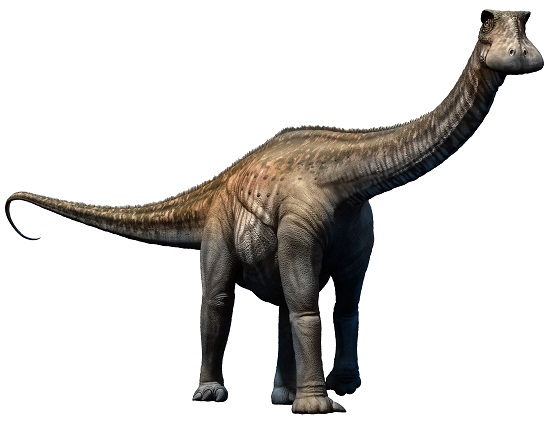
What did Nigersaurus use those 500 teeth for?
The unique mouth and teeth of Nigersaurus allowed it to feed in a way that was different from other sauropods. While most sauropods used their long necks to reach high-growing vegetation, and that’s how we think of them, and show them in media and movies.
Nigersaurus was specialized for grazing close to the ground. Its short legs and long neck enabled it to easily access low-growing plants such as ferns and horsetails without moving its large body to much. it also had a potentially lighter skull and neck to help it do this for extended periods of time. We take a look at this in the following section.
The feeding strategy of Nigersaurus can be compared to that of modern-day grazing animals like cows or sheep. Much like these animals, Nigersaurus would have used its specialized mouth and 500 teeth to efficiently strip leaves and stems from plants, processing large quantities of vegetation in a short amount of time.
This enabled the dinosaur with 500 teeth to effectively exploit a niche in its environment that may have been accessible to other, taller sauropods.
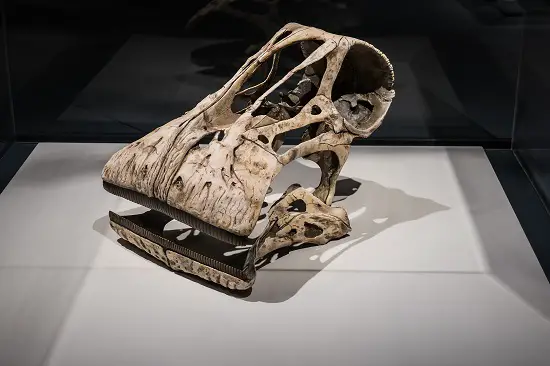
Nigersaurus Teeth
One of the most striking features of this dinosaur was its unique dental structure. Nigersaurus had more than 500 teeth, which were arranged in rows and tightly packed together in its jaw, forming a “dental battery.” Usually seen in this number in Hadrosaurus and in lesser numbers in ceratopsians.
Each tooth was small, needle-like, and sharp, designed to efficiently strip vegetation from plants. Nigersaurus’ teeth were also highly specialized, as they were constantly replaced throughout the dinosaur’s life. This rapid tooth replacement ensured that the animal always had sharp teeth for effective feeding.
The rows of teeth were organized in a manner that allowed the outer row to be engaged during feeding while the inner rows were being replaced. This dental arrangement was key to the dinosaur’s success as a herbivore, enabling it to efficiently consume large quantities of fibrous plant material.
The dinosaur’s jaw was also designed to facilitate its peculiar feeding method. Nigersaurus had a wide, U-shaped lower jaw, which acted like a rake, allowing it to effortlessly sweep through vegetation and strip leaves from plants.
Its unique dental structure, coupled with its jaw design, made Nigersaurus a highly effective and specialized herbivore, perfectly adapted to its environment.
Why did Nigersaurus skull have a Duck-Bill Snout?
The duck-bill snout of the Nigersaurus is another peculiar feature that distinguishes it from other dinosaurs. This specialized snout and tooth shape was an adaptation that allowed the dinosaur to feed more effectively in its natural environment. The wide, flat snout, resembling the bill of a duck, was a unique adaptation, in sauropods, that enabled Nigersaurus to efficiently feed on low-lying vegetation.
The duck-bill snout, combined with the U-shaped lower jaw and tooth shape, allowed Nigersaurus to cover a larger surface area while feeding. This adaptation enabled the dinosaur to strip leaves from plants with ease and consume a wide variety of plant material, including ferns, horsetails, and other low-growing vegetation. The shape of the snout also helped a side-to-side sweeping motion.
The duck-bill snout and the Nigersaurus skull housed the Nigersaurus’ complex dental arrangement, providing ample space for its numerous teeth and the necessary support for the dental battery. This relationship between the snout and teeth was essential to the dinosaur’s feeding efficiency.
What did Nigersaurus eat with those 500 teeth?
Nigersaurus was an herbivore, meaning it only consumed plants. Its unique mouth and teeth were adapted to help it efficiently graze on low-growing vegetation, such as ferns and horsetails.
The wide, shovel-like snout enabled Nigersaurus to strip leaves and stems from plants with ease, much like a modern-day lawnmower. This specialized feeding strategy allowed it to exploit a niche that may have been less accessible to other, taller sauropods.
The rapid tooth replacement rate in Nigersaurus ensured that it always had sharp, effective teeth for feeding.
This was essential for coping with the constant wear and tear from grazing on tough plants. Its feeding habits also likely had an impact on the local ecosystem, as Nigersaurus could have played a role in shaping the vegetation structure in its habitat.
We look on an evolution adaptation that may have helped Nigersaurus become a low browser below.
Nigersaurus Skull and Air pockets
One of the aspects, though it is currently just a theory, is that the bones of Nigersaurus, which were filled with air pockets, might have been used for breathing, similar to how modern birds breathe. This idea is fascinating, but it’s hard to prove since we don’t have any soft tissues from the dinosaur to study.
Birds today have a really advanced way of breathing compared to mammals like us. They have a special system of air sacs and their lungs let air flow in one direction. This means they can take in oxygen all the time, even when they breathe in and out. This breathing system is important for birds to fly, control their body temperature, and keep their bodies light.
Nigersaurus had air-filled spaces in its bones, especially in its head and backbone. This makes us think that maybe it had a similar breathing system to birds. If that’s true, it would have helped Nigersaurus stay light and possibly control its body temperature.
It’s an interesting idea to think about, but we need more research to know for sure if Nigersaurus had a bird-like way of breathing.
Well we have spent quite a lot of time on what makes Nigersaurus unique, and why it is known as the dinosaur with 500 teeth, but perhaps not enough on what it actually was. So we take a look at the Nigersaurus in the following few sections below.
What Was Nigersaurus
Nigersaurus is a dinosaur that lived around 115-105 million years ago, during the Early Cretaceous Period. It belonged to the group of dinosaurs called sauropods, well known for their long necks and large bodies. although Nigersaurus was a small example of a sauropod.
What made Nigersaurus unique was its wide, shovel-like mouth filled with 500 teeth, small enough to create almost a lawnmower effect and make them specialized for grazing on low-growing plants.
So even with those 500 teeth it was still herbivore like other sauropods. it is a relatively recent discovery, being discovered in the 1970s in the Republic of Niger – where the name stems from, and we go into its discovery in more detail below.
How Big was Nigersaurus
Nigersaurus stood out among other sauropods because of its distinct features. In terms of size, it was relatively small for a sauropod, measuring about 30 feet in length and weighing around 4 tons. This made it much smaller than other famous sauropods like Brachiosaurus or Apatosaurus.
The limbs of Nigersaurus were shorter than those of many other sauropods, which may have contributed to its slow movement. Despite its size, its long neck allowed it to graze close to the ground, easily reaching low-growing plants.
One of the most striking features of Nigersaurus was its skull. It had a lightweight, hollow structure with numerous openings, which helped reduce its weight. Which as we discussed may have made it easier for low browsing with those 500 teeth.
Its snout was wide and shovel-like, a unique , so far, design that set it apart from other sauropods and one we look at in more detail in the table below.
The mouth of Nigersaurus is particularly interesting because of its teeth. It had over 500 tiny, peg-like teeth arranged in rows along the front of its snout. These teeth were constantly replaced throughout the dinosaur’s life, ensuring a steady supply for efficient feeding at a estimated rate of about 14 days!.
How Was Nigersaurus different from other long neck dinosaurs
| Dinosaur | Teeth Size and shape | Number of Teeth | Feeding Habits | Types of Plants | Other Features | Tooth Replacement Rate |
|---|---|---|---|---|---|---|
| Nigersaurus | Small. Chisel-like | Over 500 teeth | Ground-level grazing | Ferns, horsetails | Wide, shovel-like snout | Every 14 days |
| Brachiosaurus | Medium, Spatulate | 52-54 | High browsing | Conifers, ginkgoes | Long neck, narrow snout | Every 62 days |
| Argentinosaurus | Medium-large. Spatulate | Approx. 100 | High browsing | Conifers, ginkgoes | Long neck, narrow snout | Unknown |
| Diplodocus | Small, Peg-like | Approx. 128 | Mid-height browsing | Ferns, horsetails | Long neck, narrow snout | Every 35 days |
| Apatosaurus | Medium, Spatulate | Approx. 56 | Mid-height browsing | Ferns, conifers | Long neck, narrow snout | Every 35-62 days |
Nigersaurus had the fastest tooth replacement rate of the sauropods listed, at approximately every 14 days. This rapid rate is likely due to the wear and tear caused by its specialized grazing habits.

Where was Nigersaurus Discovered
Nigersaurus was first discovered in the Republic of Niger, a country in West Africa, which is just below Algeria and above Nigeria, during the 1970s. However, it wasn’t until the 1990s and 2000s that more complete fossils were found, which provided a better understanding of this unique dinosaur.
This location would have put it firmly in the same area as both Spinosaurus and Carcharodontosaurus and at the same time period! As well as the actual prehistoric crocodile Sarcosuchus and its mimic suchomimus!

Why is it called Nigersaurus?
The name “Nigersaurus” comes from the country where it was discovered, and the Greek word “saurus,” meaning lizard. The scientific name Nigersaurus taqueti is named after the paleontologist who found more remains in 1997 and 200.
To be absolutely clear the pronunciation of this, despite vulgar internet memes, is as follows.
Knee – Jerr – Saw – Rus
it has only 4 syllables to go with those 500 teeth!
It belongs to the Rebbachisauridae family within the sauropod group. it belongs to the Rebbachisauridae family due to certain skeletal features, such as its vertebrae structure and the shape of its skull.
Other Dinosaurs in this group include Amazonasaurus, Limaysaurus and Rebbachisaurus
Did Any Other Dinosaurs Have 500 Teeth?
While 500 teeth certainly sounds like a mouthful, Nigersaurus with its 500 teeth was not the toothiest of the dinosaurs out there. In fact a whole group dinosaurs would likely have had many more teeth than the Nigersaurus.
- Nigersaurus: As mentioned earlier, this sauropod dinosaur had over 500 teeth with its unique, wide, vacuum-like mouth, ideal for grazing on plants.
- Edmontosaurus: A duck-billed hadrosaur with a dental battery, Edmontosaurus had over 1,000 teeth in its jaws.
- Shantungosaurus: This hadrosaur, closely related to Edmontosaurus, is one of the largest known duck-billed dinosaurs and had hundreds of teeth in its dental battery.
- Lambeosaurus: Another hadrosaur, Lambeosaurus had a distinctive hollow crest on its head and also had hundreds of teeth in its dental battery.
- Corythosaurus: Similar to Lambeosaurus, Corythosaurus was another crested hadrosaur that had hundreds of teeth in its dental battery for processing plants.
- Parasaurolophus: Known for its long, curved head crest, Parasaurolophus was a hadrosaur with hundreds of teeth in its dental battery.
- Gryposaurus: A duck-billed hadrosaur with a prominent nasal arch, Gryposaurus also had over 500 teeth in its dental battery.
- Maiasaura: Named “good mother lizard” because of evidence of parental care, Maiasaura was another hadrosaur with hundreds of teeth in its dental battery.
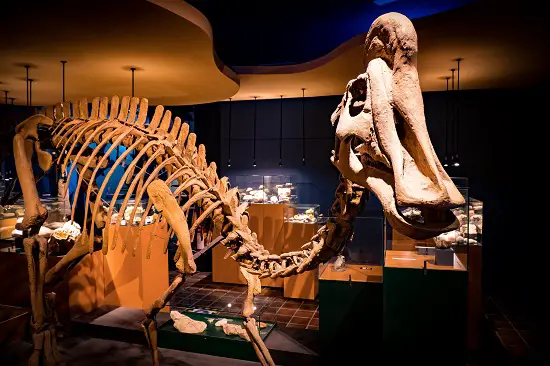
These eight dinosaurs are all known to have had over 500 teeth. Most of them are hadrosaurs, which were characterized by their dental batteries. The next, that we know of, most toothy long neck dinosaur was Diplodocus which while having over 100 teeth is still a lot less that Nigersaurus 500 teeth.
Ceratopsians, characterized by their, horns, beaked mouths and elaborate frills, typically had fewer teeth than hadrosaurs. Although they had rows of teeth in their jaws, their total number of was usually less than 500 teeth.
The teeth of ceratopsians were adapted for slicing plant material, and they had dental batteries like hadrosaurs, but the number of teeth was lower.
For example, Triceratops, one of the most famous ceratopsians, had about 40-60 teeth on each side of its jaw, with a total of around 200 teeth. So, while ceratopsians had an impressive dental arrangement, they did not typically possess over 500 teeth.
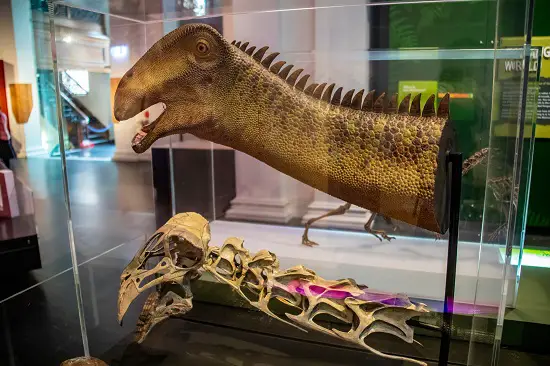
where did Nigersaurus live
During the Early Cretaceous, the area where Nigersaurus lived was a lush, riverine environment filled with diverse plant life. The climate was warm and wet, providing ideal conditions for a wide variety of plants. This abundance of vegetation would have supported numerous herbivorous dinosaurs, including Nigersaurus. it would have to considering the size of the predatory dinosaur that also live in the area.
The landscape was dominated by ferns, horsetails, and various types of conifers and ginkgoes. Nigersaurus’s feeding habits and unique mouth adaptations allowed it to take advantage of this plant diversity, effectively eating low-growing vegetation that other sauropods may have struggled to access.
In addition to the plants, the environment was home to many other dinosaur species and prehistoric animals. Some of which were certainly not herbivores.
Some of these creatures, such as the large carnivorous dinosaurs Carcharodontosaurus and Spinosaurus, would have posed a threat to Nigersaurus which we look at below.
What predators did Nigersaurus have
Despite its size and unique adaptations, Nigersaurus as well as other herbivores, faced numerous threats from predators in its Early Cretaceous habitat.
Large carnivorous dinosaurs such as Carcharodontosaurus, Suchomimus and Spinosaurus roamed the same environment, posing a significant danger to herbivores like Nigersaurus. The giant crocodile Sarcosuchus also was alive in the area at the time! So even taking a drink came with risks!
To protect itself, Nigersaurus likely relied on several defense mechanisms. First, its relatively small size and lower profile compared to other sauropods may have made it less conspicuous to predators. Although small for a sauropod its size and its probably herding behavior would have still offered protection.
It is believed that Nigersaurus, like many other sauropods, lived in groups or herds. By staying together in a group, individuals could help protect each other from predators by keeping a watchful eye and intimidating predators with their sheer numbers.
This strategy is seen in many modern-day animals, such as buffalo or wildebeest, which rely on the safety in numbers to help them survive in predator-rich environments.
Nigersaurus might have also used its long, whip-like tail as a means of defense. Although its tail was not as robust as the tail of other sauropods like Apatosaurus and certainly not its cousin Diplodocus, , it could still have been utilized as a deterrent against potential threats.
Nigersaurus F.A.Q
What is Nigersaurus nickname?
Due to its low browsing feeding it is nicknamed the Mesozoic Cow! In fact one of its discoverers, Paul Sereno, compared it to Darth Vader and a vacuum cleaner!
How did Nigersaurus move?
Nigersaurus walked on four legs, like most sauropods. Its limbs were relatively short, which likely made it a slow-moving dinosaur.
The short legs and long neck allowed it to graze close to the ground, reaching plants that other, taller sauropods could not.
What are some of the unique features of Nigersaurus?
Nigersaurus had a few unique features that set it apart from other sauropods. Its most distinctive feature was its wide, shovel-like snout filled with over 500 tiny teeth, which helped it to efficiently graze on plants.
Additionally, its skull was very lightweight, with numerous openings to help reduce its weight.
How did Nigersaurus get its name?
Nigersaurus is named after the country where it was discovered, Niger, and the Greek word “saurus,” which means lizard. The full name, Nigersaurus taqueti, honors French paleontologist Philippe Taquet, who led many of the expeditions that uncovered its fossils.
How did scientists reconstruct the appearance of Nigersaurus?
Scientists used the fossils found in Niger, including a nearly complete skull, to help reconstruct the appearance of Nigersaurus.
By studying the bones and comparing them to other sauropods, they were able to create an accurate representation of this unique dinosaur, complete with its distinctive wide, flat snout and 500 small teeth.
The Nigersaurus was one of the first to have its skull reconstructed!
What was the lifespan of Nigersaurus?
It is difficult to determine the exact lifespan of Nigersaurus since data on dinosaur lifespans is limited. However, it is estimated that most sauropods lived for several decades, with some potentially living for up to a century.
The growth rate of Nigersaurus is unknown, but like other sauropods, it is believed to have grown rapidly during its juvenile stage. Factors such as environmental conditions, food availability, and predators would have played a role in the lifespan of individual Nigersaurus.
Why did Nigersaurus have such a lightweight skull?
Nigersaurus had a lightweight skull due to its hollow structure and numerous openings, which helped reduce its overall weight. This adaptation was likely an evolutionary response to the unique feeding habits of Nigersaurus, which involved grazing on low-growing vegetation.
A lighter skull would have made it easier for Nigersaurus to move its head and neck while feeding, increasing the efficiency of its grazing strategy. Additionally, the reduced weight could have helped Nigersaurus maintain balance and maneuverability while moving through its environment.
Were there any close relatives of Nigersaurus?
Nigersaurus had several close relatives within the Rebbachisauridae family of sauropod dinosaurs. Some examples include Rebbachisaurus from Morocco, Demandasaurus from Spain, and Limaysaurus from Argentina.
These dinosaurs shared certain skeletal features with Nigersaurus, such as the structure of their vertebrae and the shape of their skulls.
References
- https://paulsereno.uchicago.edu/discoveries/nigersaurus/more_info_on_nigersaurus/
- https://ceoreviewmagazine.com/facts/do-you-know-what-dinosaur-has-500-teeth/
- https://dinosaurgeek.com/what-dinosaur-has-500-teeth/
- https://en.wikipedia.org/wiki/Nigersaurus
- https://www.vernonmorningstar.com/news/morning-start-there-existed-a-dinosaur-with-more-than-500-teeth/
- https://phys.org/news/2016-08-teeth-duck-billed-dinosaurs-dentist.html
Hi, I am Roy Ford a General Studies and English Teacher who has taught all over the world. What started as a fossil collection became a great way to teach, motivate and inspire students of all ages and all over the world about dinosaurs and from that and children’s love of dinosaurs came the site dinosaur facts for kids, a resource for all ages.




